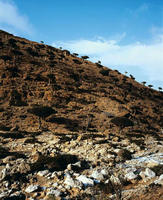You are in: Middle East -> Yemen -> Socotra Archipelago, and traditional search or Image Gallery will yield results of this site only
Socotra Archipelago
| Site number: | 1263 |
|
| Type of site: | Natural | |
| Date: | - | |
| Date of Inscription: | 2008 | |
| Location: | Middle East, Yemen, Gulf of Aden | |
Up to 75 images are shown here. Click on each for more details or on Image Gallery for more images.
Six official UN languages:
Arabic,
Chinese,
English,
French,
Russian,
Spanish
Other languages: Asturian, Basque, Bulgarian, Catalan, Croatian, Czech, Dutch, Esperanto, Farsi, Finnish, Galician, German, Hebrew, Italian, Japanese, Korean, Norwegian-bokmål, Norwegian-nynorsk, Piedmontese, Polish, Portuguese, Slovak, Swahili, Swedish, Turkish, Urdu, Welsh
Other languages: Asturian, Basque, Bulgarian, Catalan, Croatian, Czech, Dutch, Esperanto, Farsi, Finnish, Galician, German, Hebrew, Italian, Japanese, Korean, Norwegian-bokmål, Norwegian-nynorsk, Piedmontese, Polish, Portuguese, Slovak, Swahili, Swedish, Turkish, Urdu, Welsh
| Description: | Lying near the Gulf of Aden in the northwest Indian Ocean, Socotra Archipelago stretches 250 km and encompasses four islands and two rocky islets which appear as a prolongation of the Horn of Africa. The site’s biodiversity of rich and distinctive flora and fauna are of universal significance: 37% of Socotra’s 825 plant species, 90% of its reptile species and 95% of its land snail species are found nowhere else in the world. The site also sustains globally important land and sea bird populations (192 bird species, 44 of which breed there while 85 are habitual migrants), as well as numerous threatened species. Socotra’s marine life is also incredibly varied, with 253 species of reef-building corals, 730 species of coastal fish and 300 species of crab, lobster and shrimp. --WHMNet paraphrase from the description at WHC Site, where additional information is available. | |
| Socotra or Soqotra (Arabic سقطرى ; Suquṭra) is a small archipelago of four islands and islets in the Indian Ocean off the coast of the Horn of Africa some 190 nautical miles (220 mi/350 km) south of the Arabian peninsula, belonging to the Republic of Yemen. It has long been a part of the 'Adan Governorate, but in 2004 became attached to the Hadhramaut Governorate, which is much closer to the island than 'Adan (although the closest governorate would be Al Mahrah).The island was recognised by the United Nations Educational, Scientific and Cultural Organization (UNESCO) as a world natural heritage site in July 2008. The European Union has supported such a move, calling on both UNESCO and International Organization of Protecting Environment to classify the island archipelago among the environmental heritages.Socotra appears as Dioskouridou ("of the Dioscurides") in the Periplus of the Erythraean Sea, a 1st century A.D. Greek navigation aid. In the notes to his translation of the Periplus, G.W.B. Huntingford remarks that the name Socotra is not Greek in origin, but derives from the Sanskrit dvipa sukhadhara ("island of bliss").A local tradition holds that the inhabitants were converted to Christianity by Thomas in AD 52. In the 10th century the Arab geographer Abu Mohammed Al-Hassan Al-Hamdani stated that in his time most of the inhabitants were Christians. Socotra is also mentioned in The Travels of Marco Polo according to which "the inhabitants are baptized Christians and have an archbishop" who, it is further explained, "has nothing to do with the Pope at Rome, but is subject to an archbishop who lives at Baghdad". They were Nestorians but they also practiced ancient magic rituals despite the warnings of their archbishop.In 1507, Portugal landed an occupying force at the then capital of Suq, to "liberate" the assumed friendly Christians from Arab Islamic rule. However they were not welcomed as enthusiastically as they had expected and abandoned the island four years later.The islands passed under the control of the Mahra sultans in 1511. Later, in 1886 it became a British protectorate, along with the remainder of the Mahra State of Qishn and Socotra. For the British it was an important strategic stop-over. The P&O ship Aden sank after being wrecked on a reef near Socotra, in 1897, with the loss of 78 lives.In October 1967 the Mahra sultanate was abolished. On November 30th Socotra became part of the People's Republic of South Yemen (later to become the People's Democratic Republic of Yemen). Today it is part of the Republic of Yemen. --Wikipedia. Text is available under the Creative Commons Attribution-ShareAlike License. | ||
| Source: | http://whc.unesco.org/en/list/1263 | |
| Reference: | 1. UNESCO World Heritage Center, Site Page. | |









